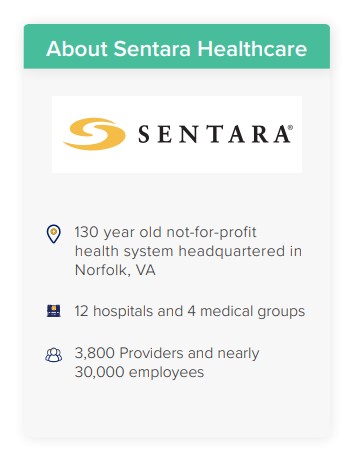






A Health System's Journey to Future-proofing Credentialing and Privileging

About the Customer
Sentara Healthcare is a not-for-profit health system operating 300 sites of care, including 12 hospitals, with 3,800 providers. HealthStream's solution enabled Sentara to standardize their processes, taking everything online for a paperless approach. When faced with COVID-19 and pandemic stresses, Sentara was able to deploy global updates to grant privileges and implement disaster privileges.

Overview
For more than 125 years, Sentara has beencommitted to helping people who want the mostdedicated medical professionals helping themthrough every stage of life. Over the years, theyhave expanded their offerings and grown as anintegrated healthcare system throughout Virginia,North Carolina and beyond. Today, they operatemore than 300 sites of care, including 12 hospitals.
Over the past year, Sentara has faced one of itsgreatest challenges: streamlining processes andreinventing systems in order to deploy caregiversas quickly as possible to where they are mostneeded. Fortunately, their continual commitment toinnovation positioned them to tackle this challengehead on.

Laying the Foundation
In 2011, Sentara determined it was time to upgrade their credentialing and privilegingprocesses. Their operations were being challenged by:
- Paper-based Processes Sentara's previous credentialing and privileging solution stored data effectively, but the credentialing and privileging process was still paper based, and the paper files were stored electronically. There was no ability to report or manipulate those stored documents.
- Delineation of Privileges Each individual medical staff felt strong ownership of their process for evaluating and recommending individual providers to provide specific patient care services within their healthcare facility. This created a cumbersome privileging process for providers, chair, and chiefs and the medical staff professionals who supported them.
- Growing Demand for CVO Services As individual medical staff offices within the health system experienced turnover, growth, and other significant business challenges, a preference to centralize credentialing and privileging grew.

Paving the way to the Future
Sentara has a long history of focusing on quality and innovation. When the need toupgrade credentialing and privileging processes and grow a true CVO arose, theorganization understood evaluating and pursuing new technology would be key to thistransformation.
Sentara knew they needed to convert to standardized, paperless processes if their CVOwas going to be able to serve multiple hospitals and medical groups, but they determinedthat bringing all processes online at once wasn't necessarily the best way to launch. Theytook a phased approach to conversion and started with the processes that would beeasiest to standardize such as initial applications and the reappointment cycle, as thesedid not require extensive review and approval. From there, they turned their focus onprivileging.
"Innovation is part of the culture at Sentara.When I started there, I knew it was part of myrole to bring innovation to the table."
Paige Martin; Director, Medical Staff Services

Disaster Strikes
On March 11, 2020, COVID-19, was declared a pandemic by the World HealthOrganization. Two days later, a national emergency was declared in the US. Sentara knewthe pandemic would soon strain its resources. The CVO rapidly recommended that thebest way for providers to obtain authorization to practice in way that would enable themto meet the demand for increased clinical resources would be the implementation ofdisaster privileges.
Disaster privileges refer to privileges granted to qualified medical professionals to providepatient care when a major event creates a surge of patients and/or shortage of providers.Disaster privileges are temporary, but they allow privileged providers to care for patientsfor as long as needed during the course of the event.
Sentara's CVO worked closely with their board and their medical staff attorney to clarifythe specifics of disaster privileging and the operational issues involved. Upon announcingthat disaster privileges would be implemented, requests began to pour in. Initially, theCVO received requests via spreadsheets, but that rapidly became too much to manage.Fortunately, Sentara was able to use their HealthStream solution to deploy a global updatewhich granted privileges to any provider who had privileges within the system andallowed them to work outside their specialty as needed. For example, a general surgeonwould be allowed to function as a general physician.
Implementing disaster privileges was no easy feat, but Sentara's medical servicesprofessionals didn't miss a beat, as they transitioned from working onsite to working 100percent remotely. They had the technology in place to get the job done.
"We aim to convert the distribution of initialand reappointment letters to an electronicprocess. As well, make broader use of theProvider Assessment Portal. And, perhapsour biggest initiative ahead, to fullystandardize our privileges through migration toCredentialStream."
Paige Martin; Director, Medical Staff Services

Looking Ahead
Sentara is on a mission to improve health every day. They understand that they can'tget there by remaining static. In order to be sure that they can deliver the right care, bythe right caregiver, at the right time, place and cost whether they are in the middle of adisaster or not, they will continue to invest in their credentialing and privileging processes.Next up, they plan to:
- Convert the distribution of initial and reappoint letters to an electronic process
- Make broader use of the Provider Assessment Portal
- Fully standardize privileges by migrating to CredentialStream and taking advantage of a library of continuously updated best-practice, evidence-based, specialty-specific privilege forms

Pro Tips
During her 25+ year tenure, Paige Martin successfully established the organization's CVOfrom the ground up. She has great advice for organizations looking to future-proof theirprivileging.
- Provider data drives the most fundamental processes in the healthcare system. It connects patients with healthcare professionals, assists with licensing providers, and helps secure payment for services. Be sure providers are entered consistently and accurately into your credentialing and privileging solution.
- When you're moving from a paper-based process, start by moving your application and verification online first. HealthStream's "Verify Now" functionality was real game changer for us. Incremental wins will help you get your medical staff onboard.
- Make sure you have good data sharing capabilities so your organization can get to know providers by reviewing their files and you can complete Electronic Committee Reviews. This helps avoid unnecessary meetings, while keeping everyone comfortable with the process.
